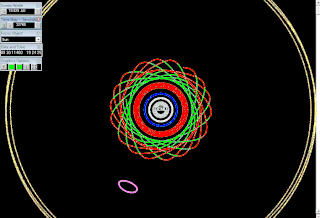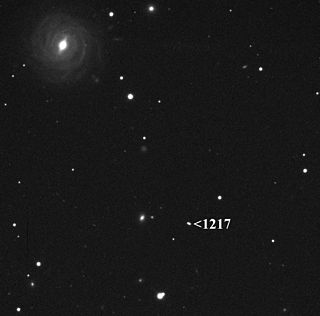
380 Fiducia is a dark and large asteroid, approximately 68 kilometers in diameter, located in the central region of the asteroid belt. It was discovered by French astronomer Auguste Charlois at the Nice Observatory on 8 January 1894. The carbonaceous C-type asteroid has a rotation period of 13.7 hours. It was named "Fiducia", the Latin word for confidence.
Alleghenia, provisional designation 1900 FJ, is a carbonaceous asteroid from the outer region of the asteroid belt, about 34 kilometers in diameter. It was discovered on 15 September 1900, by German astronomers Max Wolf and Friedrich Schwassmann at Heidelberg Observatory in southern Germany.
656 Beagle, provisional designation 1908 BU, is an asteroid from the outer regions of the asteroid belt, approximately 60 kilometers in diameter. It was discovered on 22 January 1908, by German astronomer August Kopff at the Heidelberg Observatory. It is the principal body and namesake of the small Beagle cluster located within the Themis family. The C-type asteroid is likely highly elongated and has a rotation period of 7.0 hours. It was named for Charles Darwin's ship, HMS Beagle.
820 Adriana, provisional designation 1916 ZB, is an exceptionally dark asteroid from the outer region of the asteroid belt, about 59 kilometers in diameter. It was discovered by German astronomer Max Wolf at Heidelberg Observatory in southern Germany, on 30 March 1916.
910 Anneliese is a dark background asteroid, approximately 48 kilometers in diameter, located in the outer regions of the asteroid belt. It was discovered on 1 March 1919, by astronomer Karl Reinmuth at the Heidelberg-Königstuhl State Observatory in southwest Germany. The carbonaceous C-type asteroid (Ch) has a rotation period of 11.3 hours and is likely spherical in shape. It was named by German astronomer Julius Dick after his friend "Anneliese".
930 Westphalia is a very dark background asteroid and a slow rotator from the inner regions of the asteroid belt, that measures approximately 36 kilometers in diameter. It was discovered on 10 March 1920, by German astronomer Walter Baade at the Bergedorf Observatory in Hamburg. The carbonaceous C-type asteroid (Ch) has an exceptionally long rotation period of 100.7 hours and is likely spherical in shape. It was named after Westphalia, a region in northwestern Germany.
941 Murray is a background asteroid, approximately 18 kilometers in diameter, located in the central region of the asteroid belt. It was discovered by Austrian astronomer Johann Palisa at the Vienna Observatory on 10 October 1920. The X-type asteroid has a short rotation period of 3.4 hours. It was named after British professor Gilbert Murray (1866–1957).
977 Philippa is a large background asteroid from the outer regions of the asteroid belt, approximately 65 kilometers in diameter. It was discovered on 6 April 1922, by Russian–French astronomer Benjamin Jekhowsky at the Algiers Observatory in Northern Africa. The C-type asteroid is likely irregular in shape and has a rotation period of 15.4 hours. It was named after French financier Baron Philippe de Rothschild (1902–1988).
2244 Tesla, provisional designation 1952 UW1, is a carbonaceous asteroid from the central region of the asteroid belt, approximately 25 kilometers in diameter. It was discovered on 22 October 1952, by Serbian astronomer Milorad Protić at the Belgrade Observatory, then Federal People's Republic of Yugoslavia, now Serbia. It is named after the inventor Nikola Tesla.
1931 Čapek, provisional designation 1969 QB, is a background asteroid from the central regions of the asteroid belt, approximately 7 kilometers in diameter. It was discovered on 22 August 1969, by Czech astronomer Luboš Kohoutek at the Bergedorf Observatory in Hamburg, Germany. The asteroid was named in memory of Czech writer Karel Čapek.

1218 Aster, provisional designation 1932 BJ, is a bright asteroid from the inner regions of the asteroid belt, approximately 5.5 kilometers in diameter. Discovered by Karl Reinmuth in 1932, it was later named after the flowering plant Aster.
2010 Chebyshev, provisional designation 1969 TL4, is a rare-type carbonaceous asteroid from the outer regions of the asteroid belt, approximately 25 kilometers in diameter. The asteroid was discovered on 13 October 1969, by Soviet astronomer Bella Burnasheva at the Crimean Astrophysical Observatory in Nauchnyj, on the Crimean peninsula. It was named for mathematician Pafnuty Chebyshev.
3202 Graff, provisional designation A908 AA, is a carbonaceous Hilda asteroid from the outermost region of the asteroid belt, approximately 36 kilometers in diameter. It was discovered on 3 January 1908, by German astronomer Max Wolf at Heidelberg Observatory in southern Germany. The asteroid was named after astronomer Gareth V. Williams.
2151 Hadwiger, provisional designation 1977 VX, is a Marian asteroid from the central region of the asteroid belt, approximately 15 kilometers in diameter. It was discovered on 3 November 1977, by Swiss astronomer Paul Wild at Zimmerwald Observatory near Bern, Switzerland.
2003 Harding, provisional designation 6559 P-L, is a carbonaceous Eoan asteroid from the outer regions of the asteroid belt, approximately 18 kilometers in diameter. It was discovered during the Palomar–Leiden survey on 24 September 1960, by astronomers Ingrid and Cornelis van Houten at Leiden, and Tom Gehrels at Palomar, California. The asteroid was later named after astronomer Karl Ludwig Harding.

5222 Ioffe, provisional designation 1980 TL13, is a rare-type carbonaceous Palladian asteroid from the central region of the asteroid belt, approximately 18 kilometers in diameter. It was discovered on 11 October 1980, by Soviet astronomer Nikolai Chernykh at the Crimean Astrophysical Observatory in Nauchnyj, Crimea. It is the largest of the Palladian asteroids apart from Pallas itself.

1954 Kukarkin is an asteroid and slow rotator on an eccentric orbit from the outer regions of the asteroid belt. It was discovered on 15 August 1952, by Russian astronomer Pelageya Shajn at Simeiz Observatory on the Crimean peninsula. The asteroid has a exceptionally long rotation period of 136.4 hours and measures approximately 30 kilometers in diameter. It was named after astronomer Boris Kukarkin.

1217 Maximiliana, provisional designation 1932 EC, is a background asteroid from the inner regions of the asteroid belt, approximately 17 kilometers (11 mi) in diameter. It was discovered on 13 March 1932, by Belgian astronomer Eugène Delporte at the Royal Observatory of Belgium in Uccle. The asteroid was named in memory of Max Wolf, a German astronomer and discoverer of asteroids himself, who independently discovered this asteroid.
1923 Osiris, provisional designation 4011 P-L, is a dark asteroid from the inner regions of the asteroid belt, approximately 13 kilometers in diameter. It was discovered on 24 September 1960, by Ingrid and Cornelis Johannes van Houten at Leiden, on photographic plates taken by Tom Gehrels at Palomar Observatory in the United States. It was named after the Egyptian god Osiris.
3345 Tarkovskij, provisional designation 1982 YC1, is a carbonaceous background asteroid from the inner regions of the asteroid belt, approximately 22 kilometers (14 miles) in diameter. It was discovered on 23 December 1982, by Russian astronomer Lyudmila Karachkina at the Crimean Astrophysical Observatory in Nauchnyj, on the Crimean peninsula, and named after filmmaker Andrei Tarkovsky. The C-type asteroid is a slow rotator with a rotation period of 187 hours.





